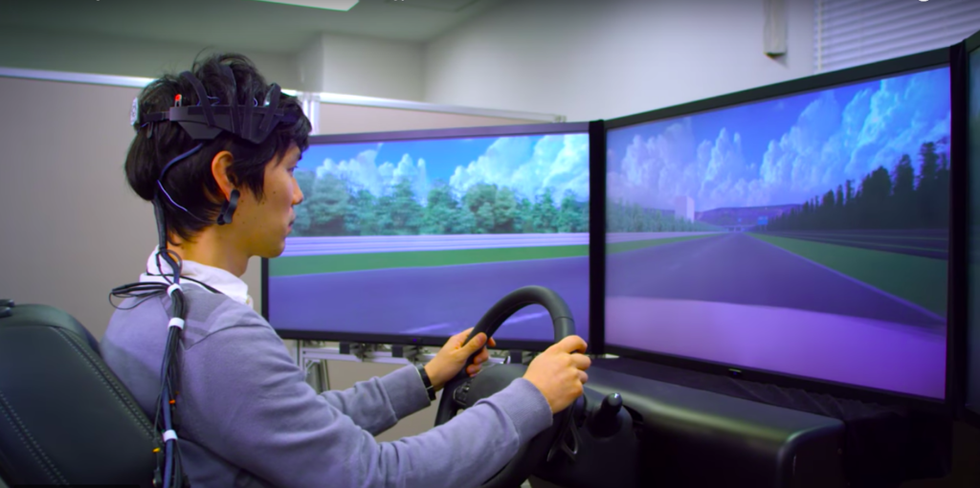As cars with more autonomous capability make their way to the road, Nissan is seeking to capture the attention of those people who aren’t ready to let go of their steering wheels. Its Brain-to-Vehicle model—which uses an electroencephalography (EEG) cap to connect driver to car—claims to anticipate and accelerate the driver’s reactions, creating an overall improved driving experience. The project also seeks to use information from the cap in self-driving mode, adjusting the environment and ride to better suit the driver’s comfort level.
How Does B2V Work?
While Nissan’s cap gathers raw data from the driver’s brain, the car’s artificial intelligence interprets it. Thus, the name Brain-to-Vehicle or B2V technology.
The prototype cap uses electroencephalography to decode thoughts while driving. The headset contains numerous electrodes that press close to the person’s scalp. In a press release, Nissan explained that only certain aspects of the communication gained through those electrodes are then transmitted to the electric vehicle.
Far from reading your subconscious thoughts, the current concept measures the motor activity-related cortical potential signals. These are the brain waves that tell your body to move, which can appear up to two seconds prior to the actual movement. Because the cap can read them faster than a person’s body can react, it can cause the car to react up to a half second faster than a driver.
Dr. Lucian Gheorghe, the senior innovation researcher at Nissan who’s overseeing the project, emphasized the technology is not about invading the thoughts of the driver.
“It’s not about reading thoughts,” he said. “But before you move your body, we know you will move.”
The driver’s decision-making brain waves will be transmitted to the car’s steering, acceleration and braking systems for an earlier response. But according to Gheorghe, that earlier response shouldn’t be perceived by the driver, who will be steering and operating the acceleration and brakes as usual. Instead, the driver will simply experience an improved sense of control and agility from their car.
"When most people think about autonomous driving, they have a very impersonal vision of the future, where humans relinquish control to the machines," according to Daniele Schillaci, an executive vice president at Nissan."B2V technology does the opposite."
Why is Nissan Focused on B2V Technology?
While many car manufacturers are targeting their efforts on gaining a larger percentage of the 21 million autonomous vehicles (AV) HIS Market predicts will be sold by 2035, others—including Nissan Toyota and BMW—plan to diversify by maintaining a line of vehicles with driver control and special features.
“We imagine a future where manual driving is still a value of society,” according to Gheorghe, who has a doctorate in applied neural technology. “Driving pleasure is something as humans we should not lose.”
Nissan doesn’t see itself at the forefront of the inner-city transportation model. Thus, the company is staying focused on improving people’s interactions with their vehicles.
“Even in the future when you have the choice not to drive, there will still be a population that would like to have the choice to drive, and this would be the time when we can increase both types of experience,” Gheorghe said.
Gheorghe perceives two purposes for the technology. As Nissan plans to continue manufacturing manual driving cars, the cap will provide better response times, giving the driver a sportier ride.
But he’s even more excited about the cap’s application in AVs. There, he expects the cap to learn how the driver expects the car to move, by recording “discord” about prior events, and make appropriate adjustments for a personalized experience.
“This is Nissan’s philosophy,” Gheorghe said. “The core value is the driver, or in the case of AV, the rider’s experience.”
He sees riding in an autonomous vehicle as much more than a shuttle or transport system, unlike many of the other rising companies in the autonomous vehicle industry.
“Even in autonomous driving, we are not building boxes in which you are sleeping,” Gheorghe said. “We are building a positive-experience delivering vehicle.”
Gheorghe also envisions using the cap to make the driving experience more comfortable. For instance, by using augmented reality, the technology can change the driver’s field of vision to construct a more tranquil environment. And in self-driving mode, the system can correct for physical discomfort, such as turning up or down the temperature in the vehicle.
As Nissan explained in a statement, “B2V interprets signals from the driver’s brain to assist with driving and to help the vehicle’s autonomous and manual systems learn from the driver.”
But this concept of using the headset to sense discord, discomfort or impaired vision would require electrodes to read much more information than simply motor-activity related brain waves. This idea could create unease about just how much information the cap is retrieving from users.
Concerns about B2V Technology
Yet fears about brain-monitoring constitute the tip of the iceberg when experts list their concerns about B2V technology in vehicles. Skepticism about this type of technology is far-reaching—ranging from its invasiveness to its overall safety and feasibility.
"Anything that would require the driver to wear any type of sensor would be deemed intrusive," Dr. Jim Sayer, director of the University of Michigan Transportation Research Institute, told NBC News. "I think that some drivers might also wonder what other thoughts are being monitored. So I'm not too sure about the practicalities of the technology's adoption."
While EEG headsets successfully control video games and prosthetic limbs, numerous neurologists expressed caution about using that technology in a normal car. The success of EEG often relies on the quality of contact between the scalp and electrodes, which can be disturbed by muscular movement. One Nissan representative admits the cap in the research model still needs to be “smaller and more stable” before people will be able to rely on it in an actual car.
Gheorghe claims that the B2V technology can differentiate between desires and decisions. He provided this scenario as an example: “when you say ‘rargh, I would like to turn right into this guy,’ but I’m not moving, if you’re not moving, there this no such MRCP [signal] appearing, so this command would not go.”
But what if the driver clearly decided to, in fact, hit the driver next to them out of a sense of road rage? Sayer wonders if the car would have some kind of failsafe to stop the car from acting on this B2V command or not.
"Is the system going to act on those types of thoughts, or only the 'legitimate' and safe ones?" he asked.
Moreover, Stanford University's Dr. Chris Gerdes, a top expert on automotive technology, remains skeptical about whether the system can even accurately sort out the pertinent brain activity.
"The brain is used for all sorts of things, so sorting out the signal you want from the 'noise' of other brain activity is often difficult," he explained. Gerdes, director of the university's Center for Automotive Research, added that this presents a "tricky problem."
Still other unanswered questions linger about the technology. How would the system respond if the driver changed their mind at the last-minute? Perhaps a new obstacle entered the environment, or the driver received new information about road conditions after deciding on an action. Could the B2V technology actually inhibit the driver’s ability to change their mind at the last split-second if the car reacts a full half second quicker than the body? Indeed, there could be practical reasons for the delay between the mind and the body that we’re not meant to override.
What’s the Future for B2V Technology?
The Japanese company unveiled and demonstrated its B2V technology at the 2018 Consumer Electronics Show in Las Vegas in January. Nissan has hinted it will roll out the new system using its IMx electric concept car, which Gheorghe called “brain-connectivity ready.”
But at this point, there’s still a long way to go before B2V technology will be ready for use on the road.
“It’s something that’s being shown in a relatively early phase, and is not yet close to implementation,” a representative for Nissan explained. “We are aiming for practical application in 5 to 10 years.”
It’s unclear whether the cap will be road-ready by the time fully autonomous vehicles reach the general public. But according to Nick Maxfield from the Japan Communications Department for Nissan, B2V technology will require some level of autonomy in the vehicle for the system to function.
Meanwhile, Nissan is also hedging its bets in future vehicle design and development: in case people don’t take to the idea of wearing a cap while driving, Maxfield said the B2V technology will remain optional, so everyone can still drive a Nissan without it.
















 @drandrealove/Bluesky
@drandrealove/Bluesky @thebulwark/Bluesky
@thebulwark/Bluesky
 @monicasanluiss/TikTok
@monicasanluiss/TikTok @monicasanluiss/TikTok
@monicasanluiss/TikTok @monicasanluiss/TikTok
@monicasanluiss/TikTok @monicasanluiss/TikTok
@monicasanluiss/TikTok @monicasanluiss/TikTok
@monicasanluiss/TikTok @monicasanluiss/TikTok
@monicasanluiss/TikTok @monicasanluiss/TikTok
@monicasanluiss/TikTok @monicasanluiss/TikTok
@monicasanluiss/TikTok @monicasanluiss/TikTok
@monicasanluiss/TikTok @monicasanluiss/TikTok
@monicasanluiss/TikTok @monicasanluiss/TikTok
@monicasanluiss/TikTok @monicasanluiss/TikTok
@monicasanluiss/TikTok @monicasanluiss/TikTok
@monicasanluiss/TikTok
 @alexamcnee/TikTok
@alexamcnee/TikTok @alexamcnee/TikTok
@alexamcnee/TikTok @alexamcnee/TikTok
@alexamcnee/TikTok @alexamcnee/TikTok
@alexamcnee/TikTok @alexamcnee/TikTok
@alexamcnee/TikTok @alexamcnee/TikTok
@alexamcnee/TikTok @alexamcnee/TikTok
@alexamcnee/TikTok @alexamcnee/TikTok
@alexamcnee/TikTok @alexamcnee/TikTok
@alexamcnee/TikTok @alexamcnee/TikTok
@alexamcnee/TikTok @alexamcnee/TikTok
@alexamcnee/TikTok @alexamcnee/TikTok
@alexamcnee/TikTok